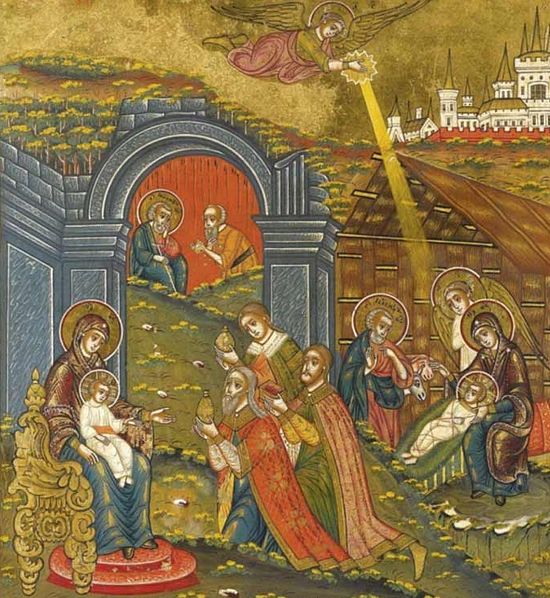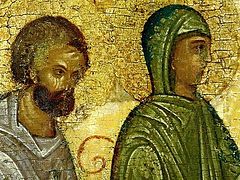 The Nativity of our Lord and Savior Jesus Christ
The Nativity of our Lord and Savior Jesus Christ
In the name of the Father, and of the Son, and of the Holy Spirit!
In today’s Gospel readings of the Royal Hours and the Liturgy we have heard the story of the Birth of the Messiah from the mouths of different Evangelists.
To confirm the fact that all that happened 2,000 years ago is true, the Apostles not only refer to the words of the witnesses but also to geographical and even astronomical evidence.
Luke the Evangelist writes that immediately before the Birth of the Infant Christ, Joseph the Betrothed and Mary had to travel from Nazareth to Bethlehem because of a census. The census that was carried out by decree of Caesar Augustus first happened when Cyrenius was governor of Syria (cf. Lk. 2:2). The Romans respected the tribal customs of the conquered peoples, so King Herod adapted the census to established traditions in Judea. St. Luke the Evangelist points precisely to this fact—Joseph’s need to go to the city of his forefather David during the census (cf. Lk. 2:4).
There is nothing strange in the fact that beyond the framework of the Gospels we know hardly anything about this first census in Judea. After all, not all the ancient manuscripts have survived. Moreover, if we believe Luke as a historian, there was also a second census after the death of Archelaus, Herod’s son. It was then that the rebel Judas of Galilee drew away many people after him (Acts 5:37). The fact that Cyrenius governed Syria at that time is attested to by chronicles[1].
Matthew the Evangelist testifies to some star that guided the Eastern Sages. In the hymns of the Royal Hours of the Eve of the Nativity the unknown country in the East is associated with Persia, and the Wise Men’s trade is identified as astrologers.
It was most probably in Persia as the successor of the great Babylonian Empire that the traditions about the Jewish Prophet Daniel who had predicted the coming of the extraordinary King and the Master of the world had been preserved. Daniel, the head of a group of Babylonian wise men, through various images predicted the gradual succession of global empires: after the Golden Age of Babylon the era of the Medes and the Bronze Age of the Persians would come, followed by the Iron Age of Greco-Roman rule with its feet of clay.
By the time of the Birth of Christ the Persian Magi may have been convinced of the fact that Daniel’s prophecies were being fulfilled. The era of the Babylonians, Medes, and Persians was over, and there were disturbances among the Greeks and Romans. So the era of the New King was at hand—that of the Anointed One, Who, according to the promise, was to come seventy weeks after King Cyrus’s decree to restore and rebuild Jerusalem (cf. Dan. 9:24).
We can also presume that the words of the diviner Balaam: there shall come a Star out of Jacob, and a Sceptre shall rise out of Israel (Num. 24:17) made the Hebrews and Persians believe that the appearance of some special star in the sky would indicate the coming of the Redeemer[2].
Seeing an unusual star in the sky, the Persian astrologers hurried to Jerusalem to bow down before the new King from Judea. Besides, according to Matthew, the Magi observed the star twice. They saw it for the first time “in the east” (cf. Mt. 2:1-2) in Persia, which we can interpret as “at dawn”, or “at sunrise”. And they saw it for the second time on their arrival in Bethlehem. The star directed them right to the house, “came and stood” over where the Baby Christ and Mary were (cf. Mt. 2:9-11).
The nature of the star remains a mystery. The opinions of Church researchers of antiquity and modern times on its nature vary. Origen and St. John Damascene assumed that it may have been a comet[3]. Specifically, the image of Halley’s Comet is depicted in Giotto’s “Adoration of the Magi” fresco at the Scrovegni Chapel (Italy). The Church writer Tertullian and Emperor Manuel I Comnenus presumed that it was a conjunction of planets. According to the German astronomer Johannes Kepler, for instance, it may have been the conjunction of Jupiter and Saturn with Mars in 6 B.C. St. John Chrysostom and Blessed Theophylact of Ohrid supposed that it was some angelic power appearing in the form of a star[4].
Be that as it may, judging by the Gospel, the star led the Wise Men as far as Jerusalem and then disappeared for a while. After the high priests and scribes had pointed to Bethlehem as the birthplace of the Leader of Israel and the Magi left King Herod, the star reappeared and showed the Persian Magi the exact location of the house of the Christ Child and Mary.
In the debates of materialists on whether or not the first census was carried out under Cyrenius and what the bright star was like, the essence of the Gospel good tidings may be lost. What matters to the faithful is that with the appearance of the star of Bethlehem the good tidings of the Birth of the Savior came into being.
Referring to historical facts of their time, the Apostles meant to stress that the Nativity of Christ was a fact and not an invention. The prophets’ promises were fulfilled.
In the land of Judah, in the city of David, the Savior Emmanuel was born from the Virgin—He is Christ the Lord. But He Who received the gifts from the Persian Magi and Who was to shepherd Israel, was born in an ordinary cave for cattle and not in palace chambers. An angel of God pointed at this as to a special sign: “a great joy to all people” would be found by the Shepherds in a manger (cf. Lk. 2:12).
Christ made Himself of no reputation, and took upon Him the form of a servant (Phil. 2:7). According to St. Theophan the Recluse, the Lord walked the path of humility and self-abasement. Realizing His equality to God, He, “having stripped Himself off the visible glory and greatness characteristic of the divine nature and belonging to Him as God… hid the glory of His divinity.” “God by nature, being equal with God, hiding His dignity, He chose extreme humility.” (Blessed Theodoret).
Self-emptying, humility, cutting off our egoism—this is the path towards heavenly glory offered to us by Christ. Neither in the emperor’s chambers, nor in the splendor of earthly glory did He offer us great hope. He contrasted the glory and riches of earthly kings with heavenly glory and treasure in heaven.
I receive not honor from men, the Lord said of Himself. How can ye believe, which receive honor one of another, and seek not the honor that cometh from God only? He said of us (Jn. 5:41, 44). The Savior did not rebuke the Pharisees for observing the outward rules of piety; He reproached them because they loved the praise of men more than the praise of God (Jn. 12:43). The Pharisees did everything for show, they liked greetings in the markets, and to be called of men, Rabbi, Rabbi (Mt. 23:7). Earthly glory blinded them. But he that is greatest among you shall be your servant. And whosoever shall exalt himself shall be abased; and he that shall humble himself shall be exalted (Mt. 23:11-12), He said to His disciples.
Self-abasement, self-emptying, and humility—this is the path of the venerable fathers who abased themselves after the example of Christ their Teacher.
He Who created the heaven and earth, established the laws of the universe, and upholds all things by the word of His power (cf. Heb. 1:3) laid Himself in a manger so, having become like human-beings in all respects, He could show us the path of divine humility and save fallen Adam.
Marveling at this, we follow the Magi with the star to Bethlehem, marvel at the miracle with the Shepherds and sing with the angels: Glory to God in the highest, and on earth peace, good will toward men (Lk. 2:14).
Amen.



